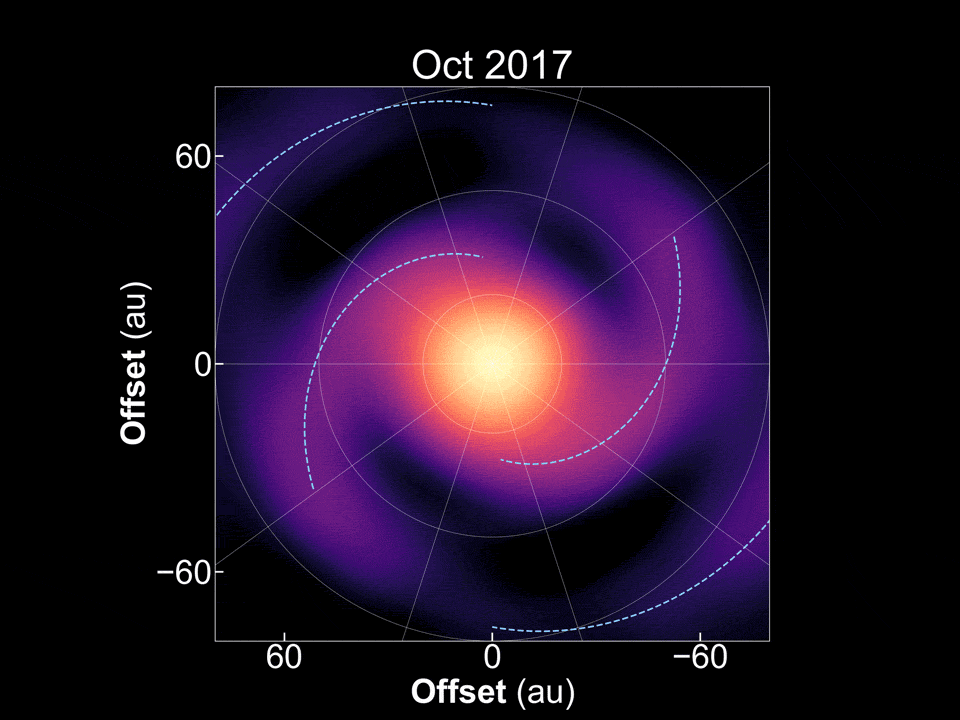There are plenty of exoplanets scattered throughout the galaxy, so it would stand to reason there are also plenty of stars that are in the process of forming new exoplanets. Tracking down stars that are in different stages of that process can shed light on the exoplanet formation process, and potentially even on how planets in our own solar system developed. But determining what star systems are going through that process, let alone where they are in the process itself, can be tricky. A new paper in Nature Astronomy from Tomohiro Yoshida and his co-authors at the National Astronomical Observatory of Japan and several other Japanese and American research institutions, seems to have found one that finally answers a mystery that has stood in planetary formation theory for decades – how do gas giant exoplanets form so far away from their stars?
One particularly egregious example of a system with exoplanets far away from its star is the HR 8799 system, which has giant planets at 20 and 70 times the distance of the Earth from our own Sun. The formation of these giant planets that far away from their host star doesn’t sit well with the “core accretion” model of exoplanet formation. In that model, dust grains housed in a “protoplanetary disk” start to stick together to form planetesimals, gradually increasing their own gravity well, and thereby attracting even more gas and dust from the local area.
For orbits of planets that are so far out, this theory doesn’t hold water – or dust as the case may be. Scientists think there isn’t enough matter in these far out orbits to create massive planets before the matter itself is blown away by solar winds or flung into interstellar space by gravitational instabilities. So how come we consistently see giant planets in these extra long orbits?
Hybrid video of the stop-motion imagery of the IM Lupin System.
Credit – ALMAJapanChannel YouTube Channel
Another theory that could answer that is “gravitational instability”. In this scenario, the protoplanetary disks that typically make up the material used for planet formation fragment and become gravitationally unstable. When they do, they form large scale “spiral arms” in the stellar system, looking kind of like the spiral arms of the galaxies they are a part of. However, these spiral arms in protoplanetary disks can also be caused by other features, such as already formed planets disrupting the gravity of the rest of the protoplanetary disk, so simply confirming the presence of spiral arms doesn’t necessarily mean gravitational instability is taking place in a system.
There is a way to differentiate the two causes of spiral arms though – watch how they move. So far, this had never been done, as these massive spiral arms move very very slowly and are very very far away. If we were able to observe one moving, if its motion was caused by gravitational instability, its arms would move at the “local Keplerian rotation” speed, in which the spiral arms match speed with the disk material, based on how far they are from the star’s gravitational pull. In this scenario, material that is in the arms that are closer to the star would rotate faster than ones that are further away. If the spiral arms were rotating “rigidly” at the same speed, then it is likely matching the speed of a planet that caused its formation rather than still in process of making one.
To observe this motion difference, ideally there would be data taken on the same star system over multiple years, and that is exactly what the authors found. They took data sets from four different observing runs of the Atacama Large Millimeter/submillimeter Array (ALMA) radio telescope in Chile over the course of seven years. In particular, they focused on a star with spiral arms called IM Lupi.
Fraser explains exoplanet sizes and why there’s a gap in them.
Located about 515 light years away in the constellation Lupus, IM Lupi is ideal for this type of observation because it has very prominent spiral arms, with a disk that’s large enough to potentially be gravitationally unstable. And, possibly more importantly, all other alternatives for the creation of the spiral arms, such as shadows from other systems, have been ruled out in its case.
Using the data from ALMA, the authors made what is essentially a stop motion image of the spiral arms as they are moving. Importantly they found the arms were moving in time with the Keplerian motion, not rigidly like spokes on a bike, as might be suggested if they were created by an existing planet.
This provides proof for the first time that gravitational instability does happen in these spiral arms of protoplanetary disks, and that it could lead to the formation of large exoplanets far away from their star. But there’s plenty of follow-up work to do, including further observations of IM Lupi using ALMA and some follow up observations about the impact of “infall” – i.e. gas and dust from the surrounding interstellar medium contributing to the two-arm structure around the star.
Ultimately the paper represents another step forward in our understanding of exoplanet formation, and another example that our knowledge will continue to grow off of. ALMA is continuing its operation, so even more stop-motion imagery could be forthcoming for other stars with protoplanetary disks in different formation stages. But for now, let’s just appreciate the beauty of these images and the science that they’ve already allowed us to do.
Learn More:
NAOJ – Motion of Planet-Forming Spirals Captured on Video
T. C. Yoshida et al. – Winding motion of spirals in a gravitationally unstable protoplanetary disk
UT – This Massive Gas Giant Orbiting a Tiny Red Dwarf Tests Our Planet Formation Theories
UT – New Theory Explains Why So Many Exoplanets Crowd Close to Their Stars
